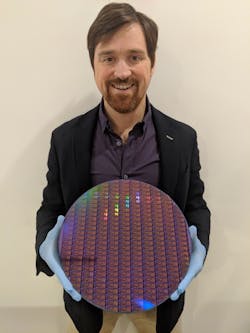Cooperative R&D agreement for silicon photonics forms
The Air Force Research Laboratory (AFRL; Wright-Patterson Air Force Base, OH) has approved a cooperative research and development agreement (CRADA) between AFRL’s Nanoelectronic Materials Branch and Iris Light Technologies (Chicago, IL) that will focus on hybrid silicon lasers, which are part of a broader field of technology known as silicon photonics.
Because of its atomic structure, silicon can be made to either conduct electricity or to block it. Its ability to control current flow is achieved by adding a small amount of another element, such as boron or phosphorus, to silicon’s crystal lattice. As with nearly all electrical components, passing current through such “doped” silicon devices in a circuit always produces heat, but little light, limiting its use for LEDs or lasers.
Recently, some limited success in getting a silicon chip to emit a significant amount of light has been achieved by alloying silicon with germanium. The process is somewhat tedious, however, and germanium is expensive. An “easier” process using less expensive materials has remained elusive.
AFRL research scientist Dr. Steven Mckeown is part of a team that is investigating silicon photonics with a goal of finding a better way to fabricate hybrid devices that make possible the integration of lasers onto silicon chips, as silicon has the problem of poor optical gain, Mckeown says.
Part of the goal is to find a less expensive and more reliable way to manufacture the “on-chip lasers,” as well as a way to enable their mass production. One method AFRL is investigating involves a type of “photonic ink” developed by Iris Light Technologies, AFRL’s partner in the CRADA. Iris Light Technologies can use this photonic ink to print laser gain material directly onto passive silicon chips—the company aims to modify the ink so that it will emit light when it is pumped by electric current. The ink is capable of emitting light over a broad spectrum, from visible to the near-infrared.
Such “nanomaterial lasers” would have many practical applications—one would be in the circuitry of computers. Data processing speed is limited by resistance to the flow of electrons in the copper lines of the computer’s circuitry. This resistance produces heat. Using light, or photons, instead of electrons means less resistance and less heat, which in turn means faster data processing.
Other applications of special interest to AFRL are hyperspectral sensing, lidar, and radio frequency (RF) photonics.
With the CRADA, Iris will provide AFRL with a set of test chips.
